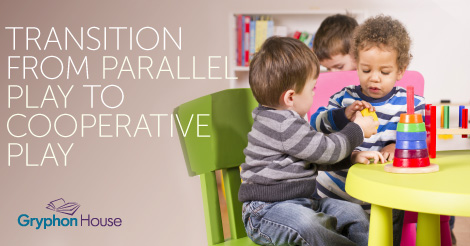
Social activities for toddlers and preschoolers play a key part in the social and emotional development of young children. However, many parents may wonder how to successfully help their child transition from parallel play, seen amongst young toddlers, to cooperative play as their child begins to grow and enter preschool.
Parallel play is a form of play where children, usually aged two or three, begin playing alongside each other and engage in similar, or entirely different activities, than the children they’re surrounded by. Even though they may seem independent from these other children, and uninfluenced by their presence or behavior, that form of contact between children is very important to them. As they get older and begin to interact more, cooperative play focused on activities such as social games for toddlers and preschoolers, becomes increasingly important.
Learning to share, cooperate with others, and take turns, are all lessons that young children must receive when transitioning to cooperative play. Cooperative play is interactive, social, and important for children as they begin to express and share ideas with other children their age. Children should be allowed to explore the idea of cooperative play on their own through staging their own forms of play from games to dress-up: anything where children can socialize and learn from one another. However, adult guidance is still needed to help them begin to grasp the concept of social skills such as problem solving.
Tina Nocera’s book, Parents Ask, Experts Answer: Nurturing Happy, Healthy Children, provides expert advice for parents looking to shape the guidance they provide to their children as they embark on the exciting journey that is transitioning from parallel play to cooperative play.
Here’s a scenario that you may face during this transition period and some helpful advice you can use with your child when it comes to taking turns, teaching how to share, and ultimately, how to play cooperatively with others.
Q: My three-year-old refuses to share at home as well as school. Help!
Experts Answer
Jill Wodnick
· Developmentally, it is normal for a child to want to keep his own items. A role of parenting is to help children learn strategies to successfully interact with others. Refusing to share is all part of your child’s sense of self right now. You can teach your child sharing through play, giving him opportunities to take turns and let you play with his toys. Make it fun: Try taking turns pretending to make banana bread by stirring the dough five times each. Try swinging a rope five times each then passing it along. The more you can make sharing and turn-taking fun experiences, the more comfortable your child will become with the concept.
Ilyse Gorbunoff
Sharing is difficult at three. Children this age really don’t understand that others have needs, too. I always found that a timer was helpful in teaching children to share. If your child wants to play with a toy and his friend does, too, tell each child that he can have the toy for five minutes. Set the timer and reinforce that when it rings it will be time to switch. Help the child who is waiting to find something else to play with while he waits. When time is almost up, give a warning that the timer will ring soon. When the timer rings, make the switch. Then, help the first child find something else to do. If he cries or gets upset, empathize and help him deal with it, but don’t give in. Explain that when the timer rings again, it will be his turn. Also, spend time with your child talking about sharing, reading books, and teaching him about empathy, as well as how to be a good friend. It is a hard lesson to learn, but with patience and time your child will learn to share.
Derick Wilder
· Not being able to share is a very common and normal behavior for a three-year-old, as it’s a skill that is only learned over a long period of time. There are things parents can do to help the situation, beginning with setting a good example and taking every opportunity to show your child how to share.
· Like many behaviors, this can be taught in phases. Start by having your child show a favorite toy to a friend and letting the child touch it. Next, casually ask your child to pass a toy to a friend. Even if it’s not one of his favorites, repeating this simple act is a step toward turning sharing into a habit. During this process, make sure to praise your child with each positive step. In addition, you might want to designate a few toys as special and take them out of the room when other children are going to be around.
Author(s)Tina Nocera
Anna Wilmoth
Marketer. Publisher. Reporter. Educator. Mother. Runner. Explorer. Anna served as director of marketing for Gryphon House from Oct 2014 - May 2017.

